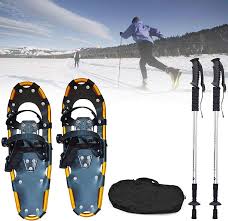Snow Shoes: Your Essential Winter Gear
As winter approaches and the landscape transforms into a winter wonderland, it’s time to gear up for snowy adventures. One essential piece of equipment that can make your winter outings more enjoyable and safe is a pair of snow shoes.
Snow shoes have been used for centuries by various cultures around the world to navigate through snowy terrain. These specially designed footwear help distribute your weight over a larger surface area, preventing you from sinking deep into the snow with each step.
Types of Snow Shoes
There are several types of snow shoes available, each catering to different activities and terrains:
- Traditional Snow Shoes: These are typically made of wood and rawhide lacing, resembling the classic design used by indigenous peoples for centuries.
- Modern Snow Shoes: Constructed with lightweight materials such as aluminium or composite materials, modern snow shoes offer improved durability and performance.
- Backcountry Snow Shoes: Designed for rugged terrains and steep slopes, backcountry snow shoes provide stability and traction in challenging conditions.
- Running Snow Shoes: Sleeker and lighter than traditional models, running snow shoes are ideal for those looking to maintain their fitness during the winter months.
Tips for Choosing Snow Shoes
When selecting snow shoes, consider the following factors:
- Sizing: Ensure that your snow shoes fit comfortably with your winter boots.
- Traction: Look for models with aggressive crampons or cleats for enhanced grip on icy surfaces.
- Weight Capacity: Choose snow shoes that can support your body weight along with any additional gear you may be carrying.
- Terrain: Select the appropriate style of snow shoe based on the type of terrain you’ll be traversing.
Caring for Your Snow Shoes
To prolong the lifespan of your snow shoes, remember to clean them after each use to remove dirt and moisture. Store them in a cool, dry place away from direct sunlight to prevent damage to the materials.
In conclusion, investing in a reliable pair of snow shoes can enhance your winter adventures by providing stability, traction, and comfort in snowy conditions. Whether you’re exploring backcountry trails or enjoying a leisurely stroll through a snowy park, snow shoes are an essential piece of gear for any winter enthusiast.
Five Essential Tips for Selecting and Using Snow Shoes Safely
- Choose snow shoes with good traction to prevent slipping on icy surfaces.
- Adjust the bindings properly to ensure a snug and secure fit for comfort and safety.
- Practice walking in snow shoes before heading out on longer treks to get used to the different stride required.
- Avoid walking on very steep or icy slopes where snow shoes may not provide enough grip.
- Always check the weather conditions and avalanche risks before venturing out with snow shoes.
Choose snow shoes with good traction to prevent slipping on icy surfaces.
When selecting snow shoes for your winter adventures, prioritise models with excellent traction to minimise the risk of slipping on icy surfaces. Opting for snow shoes equipped with aggressive crampons or cleats can significantly enhance your grip and stability, ensuring a safer and more enjoyable experience in snowy conditions. By choosing snow shoes with superior traction, you can confidently navigate icy terrains without compromising your safety or comfort.
Adjust the bindings properly to ensure a snug and secure fit for comfort and safety.
Adjusting the bindings of your snow shoes is a crucial step to guaranteeing both comfort and safety during your winter excursions. A snug and secure fit not only enhances your overall experience by preventing discomfort and blisters but also ensures that you have better control and stability while navigating through snowy terrain. Properly adjusted bindings can help distribute your weight evenly, reducing the risk of slips or falls, ultimately allowing you to enjoy your snowy adventures with peace of mind.
Practice walking in snow shoes before heading out on longer treks to get used to the different stride required.
Before embarking on longer treks in snowy terrain, it is advisable to practice walking in snow shoes to familiarise yourself with the unique stride they require. The wider profile and added weight of snow shoes can alter your gait and balance, so taking the time to adjust and feel comfortable in them beforehand can greatly enhance your overall trekking experience. By practising walking in snow shoes, you can build confidence and efficiency, ensuring a more enjoyable and safe journey when venturing out into the winter wilderness.
Avoid walking on very steep or icy slopes where snow shoes may not provide enough grip.
When venturing out with snow shoes, it is crucial to exercise caution and avoid walking on very steep or icy slopes where the terrain may exceed the grip capabilities of the snow shoes. In such conditions, the risk of slipping or losing traction is heightened, potentially leading to accidents or injuries. It is advisable to assess the terrain beforehand and choose routes that are suitable for snow shoeing, ensuring a safe and enjoyable winter adventure.
Always check the weather conditions and avalanche risks before venturing out with snow shoes.
Before embarking on any snowshoeing excursion, it is crucial to diligently assess the prevailing weather conditions and potential avalanche risks in the area. Snowshoeing in unpredictable weather or high-risk avalanche zones can pose serious hazards to your safety. By staying informed and prepared, you can make informed decisions about when and where to enjoy your snowshoeing adventures, ensuring a safer and more enjoyable experience in the winter wilderness.

